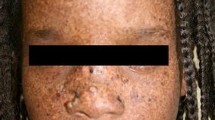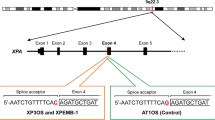Abstract
The rare hereditary disease xeroderma pigmentosum (XP) is clinically characterized by extreme sun sensitivity and an increased predisposition for developing skin cancer. Cultured cells from XP patients exhibit hypersensitivity to ultraviolet (UV) radiation due to the defect in nucleotide excision repair (NER), and other cellular abnormalities. Seven genes identified in the classical XP forms, XPA to XPG, are involved in the NER pathway. In view of developing a strategy of gene therapy for XP, we devised recombinant retrovirus-carrying DNA repair genes for transfer and stable expression of these genes in cells from XP patients. Results showed that these retroviruses are efficient tools for transducing XP fibroblasts and correcting repair-defective cellular phenotypes by recovering normal UV survival, unscheduled DNA synthesis, and RNA synthesis after UV irradiation, and also other cellular abnormalities resulting from NER defects. These results imply that the first step of cellular gene therapy might be accomplished successfully.
Similar content being viewed by others
References
Abrahams PJ, Schouten R, van Laar T, Houweling A, Terleth C, van der Eb AJ. Different regulation of p53 stability in UV-irradiated normal and DNA repair deffcient human cells. Mutat Res. 1995;336:169–80.
Ahrens C, Grewe M, Berneburg M et al. Photocarcinogenesis and inhibition of intercellular adhesion molecule 1 expression in cells of DNA-repair-defective individuals. Proc Natl Acad Sci USA. 1997;94:6837–41.
Bredberg A, Kraemer KH, Seidman M. Restricted ultraviolet mutational spectrum in a shuttle vector propagated in xeroderma pigmentosum cells. Proc Natl Acad Sci USA. 1986;83:8273–7.
Busch D, Greimer C, Lewis K. Summary of complementation groups of UV-sensitive CHO cell mutants isolated by large-scale screening. Mutagenesis. 1989;4:349–54.
Cleaver J, Kraemer KH. Xeroderma pigmentosum and Cockayne syndrome. In: Scriver CR, Beaudet AL, Sly WS, Valle D, eds. The metabolic and molecular bases of inherited disease. 7th edn. NewYork: McGraw Hill; 1995; III:4393–419.
Carreau M, Eveno E, Quilliet X et al. Development of a new easy complementation assay for DNA repair deficient human syndromes using cloned repair genes. Carcinogenesis. 1995a;16:1003–9.
Carreau M, Salvetti A, Quilliet X et al. Functional retroviral vector for gene therapy of xeroderma pigmentosum group D patients. Hum Gene Ther. 1995b;6:1307–15.
Danos O, Mulligan RC. Safe and efficient generation of recombinant retrovirus with amphotropic and ecotropic host ranges. Proc Natl Acad Sci USA. 1988;85:6460–4.
Dumaz N, Duthu A, Ehrart JC et al. Prolonged accumulation of the p53 protein in xeroderma pigmentosum, trichothiodystrophy and Cockayne's syndrome repair-deficient fibroblasts is dependent on unrepaired lesions on the transcribed strand of cellular genes. Mol Carcinogen. 1997a;20 [In press].
Dumaz N, Drougard C, Quilliet X, Mezzina M, Sarasin A, Daya-Grosjean L. Recovery of normal p53 response in DNA repair deficient fibroblasts after retroviral-mediated correction by the XPD human gene. Carcinogenesis. 1997b [Submitted].
Kraemer KJ, Lee MM, Scotto J. Xeroderma pigmentosum. Cutaneous ocular and neurological abnormalities in 830 published cases. Arch Dermatol. 1987;123:241–50.
Marionnet C, Benoit A, Benhamou S, Sarasin A, Stary A. Characteristics of UV-induced mutation spectra in human XP-D/ERCC2 gene-mutated xeroderma pigmentosum and trichothiodystrophy cells. J Mol Biol. 1995;252:550–62.
Marionnet C, Quilliet X, Benoit A, Armier J, Sarasin A, Stary A. Recovery of normal repair and mutagenesis in trichothiodystrophy cells after transduction of the XPD human gene. Cancer Res. 1996;56:5450–6.
Mezzina M, Eveno E, Chevalier-Lagente O et al. Correction by the ERCC2 gene of UV-sensitivity and repair deficiency phenotype in a subset of trichothiodystrophy cells. Carcinogenesis. 1994;15:1493–8.
Miller AD, Rosman GJ. Improved retroviral vectors for gene transfer and expression. Biotechniques. 1989;7:980–9.
Puvion-Dutilleul F, Sarasin A. Chromatin and nucleolar changes in xeroderma pigmentosum cells resemble aging-related nuclear events. Mutat Res. 1989;219:57–70.
Quilliet X, Chevalier-Lagente O, Eveno E et al. Long-term complementation of DNA repair deffcient human primary ffbroblasts by retroviral transduction of the XPD gene. Mutat Res. 1996;364:161–9.
Quilliet X, Chevalier-Lagente O, Zeng L et al. Retroviral-mediated correction of DNA repair defect in xeroderma pigmentosum cells is associated with recovery of catalase activity. Mutat Res. 1997 [In press].
Stary A, Sarasin A. The genetic basis of xeroderma pigmentosum and trichothiodystrophy syndromes. Cancer Surv. 1996;26:153–71.
Vuillaume M, Calvayrac R, Best-Belpomme M et al. Deficiency in the catalase activity of xeroderma pigmentosum cell and simian virus 40-transformed human cell extracts. Cancer Res. 1986;46:538–44.
Zeng L, Quilliet X, Chevalier-Lagente O, Eveno E, Sarasin A, Mezzina M. Retrovirus-mediated gene transfer corrects DNA repair defect of xeroderma pigmentosum cells of complementation groups A, B and C. Gene Ther. 1997;4:1077–84.
Author information
Authors and Affiliations
Rights and permissions
About this article
Cite this article
Zeng, L., Sarasin, A. & Mezzina, M. Retrovirus-mediated DNA repair gene transfer into xeroderma pigmentosum cells: Perspectives for a gene therapy. Cell Biol Toxicol 14, 105–110 (1998). https://doi.org/10.1023/A:1007477820594
Issue Date:
DOI: https://doi.org/10.1023/A:1007477820594




